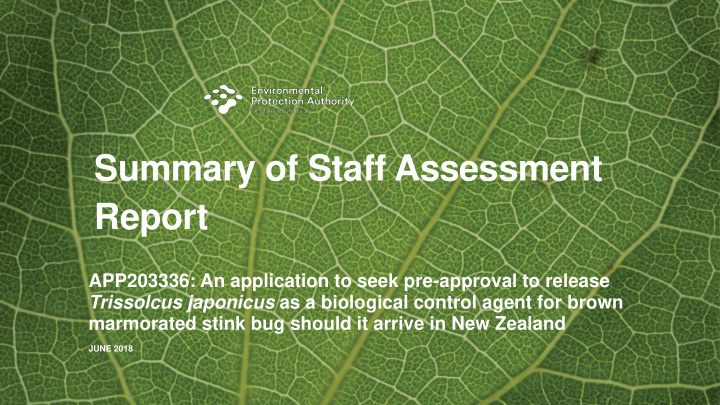



Summary of Staff Assessment Report APP203336: An application to seek pre-approval to release Trissolcus japonicus as a biological control agent for brown marmorated stink bug should it arrive in New Zealand JUNE 2018
The application 2 • The Brown Marmorated Stink Bug Council lodged an application with the EPA on 26 March 2018 seeking pre-approval to release Trissolcus japonicus as a biocontrol agent for brown marmorated stink bug (BMSB) should it arrive in New Zealand. • The application was publicly notified. The EPA received 69 submissions: 65 submitters supported the application, two submitters neither supported nor opposed the application and two opposed the application. Eighteen submitters indicated they wish to be heard.
Risk assessment 3 • Trissolcus japonicus as a tool in an eradication response. • Conditional release. • We assessed the risks and benefits to the environment, market economy, people and communities and to Māori and their relationship with the environment.
Benefits assessment 4 • We considered the benefits from Trissolcus to the market economy, environment and people and communities. • BMSB and its effects to plant production industries. • Economic analysis. • Costs include reduced yields across a range of horticulture crops; reducing exports and domestic sales; increased agrichemical use; higher labour costs to monitor and treat BMSB; lower export prices due to concerns about chemical residues. • The use of Trissolcus in an eradication response could protect vulnerable horticulture regions, as well as conservation estate, from becoming infested with BMSB. That could eliminate or minimise the costs involved to control BMSB in those environments. • We concluded that there would be significant economic benefits from the use of T. japonicus .
Benefits assessment 5 • The environment: damage from wider agrichemical applications; feeding damage to native plants. • We considered the use of Trissolcus could have important beneficial effects on the environment by contributing towards or eliminating collateral damage to other organisms from chemical control or feeding by BMSB. We concluded these effects to be low . • People and communities: nuisance factor, allergen production, losses in amenity values due to damages to ornamental plants, decrease in household incomes. • We concluded benefits to be low to medium .
Potential adverse effects 6 • Adverse effects on the environment: direct effects and indirect effects • Host range experiments, field surveys and chemical ecology: the staff assessment report summarises experimental work conducted in New Zealand, USA and China. • We found there would be negligible adverse effects from the use of Trissolcus as part of an eradication strategy on beneficial stink bugs. • We further concluded that any adverse effects on endemic stink bugs would be low.
Potential adverse effects 7 • Adverse indirect effects on the environment. • Cross-breeding, hyperparasitism, competition for shared resources. • We assessed these areas in the staff assessment report and noted that although indirect effects may occur, they would have negligible effects.
Conclusions regarding the benefits 8 and risks • The benefits to the market economy are significant, the benefits to the environment are low and benefits to people and communities are low to medium. • We assessed the adverse effects to the environment as negligible, but assessed effects on endemic stink bugs as low. • We considered where Trissolcus would establish an undesirable population and potential for eradication of the biocontrol agent if a population becomes undesirable. • We took the proposed controls into consideration. • We conclude the beneficial effects outweigh the adverse effects.
Minimum standards 9 • We assessed the conditional release of Trissolcus japonicus against the minimum standards in the HSNO Act. • We considered the controls that will be imposed, whether the controls are likely to be effective in meeting the objective of the controls and the ease by which the organism could be recovered and eradicated if it formed a self-sustaining population. • We considered that Trissolcus meets the minimum standards.
Relationship of Māori to the 10 Environment • Kaupapa Kura Taiao made a cultural risk assessment of the application and concluded the benefits of Trissolcus are likely to outweigh its disbenefits. • The potential risks to Māori interests would probably be acceptable. • There are some significant uncertainties and information gaps that remain. The uncertainties are in relation to potential impacts on culturally significant species and wider ecosystem effects. • The application is not inconsistent with Māori cultural beliefs and environmental frameworks.
Proposed controls 11 • The EPA proposes a set of controls to manage the use of Trissolcus . • The controls stipulate when Trissolcus may be released; the duration of an approval; who may use the approval; notification of the use of the approval. • Provisions to review.
Recommendation 12 • Our assessment has found that the benefits of conditionally releasing Trissolcus japonicus outweigh any identified risks or costs. We also found that T. japonicus meets the minimum standards set out in section 36 of the HSNO Act. We therefore recommend that the Decision-making Committee approves the application and grants a conditional release approval with controls.
For more information contact: General enquiries Phone +64 4 916 2426 Fax +64 4 914 0433 info@epa.govt.nz
Recommend
More recommend